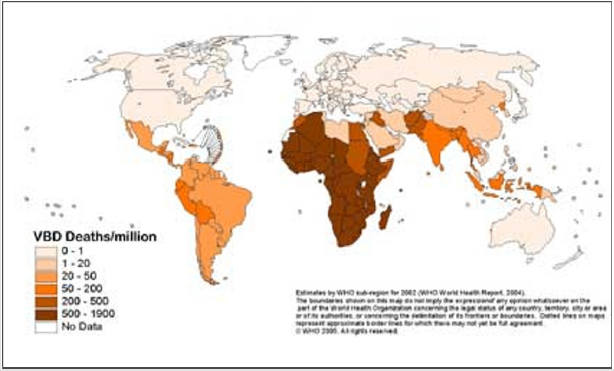Use of Insecticide-Treated Nets (ITN) Against Diseases Vectors and Sucking Blood Arthropods
Introduction
Sucking Arthropods and Related Families in the World are
Mosquitoes (Culicidae), Sand flies (Psychodidae), Black flies (Simuliidae), Biting Midges (Ceratopogonidae), Tabanids (Tabanidae), Stable fly (Muscidae), Tsetse fly (Glossinidae), Kissing bug (Reduviidae), Bedbug (Cimicidae), Flea (Pulicidae), Head and body louse (Pediculicidae), Crab (Phthiridae), Mite (Trombiculidae), Hard Ticks (Ixodidae), Soft ticks (Argasidae). They transmit deferent diseases to human. World Health Organization listed the main vector borne disease in the world (Table 1). Vector-borne diseases are illnesses caused by pathogens and parasites in human populations. Every year more than one billion people are infected, and more than one million people die from vector-borne diseases including malaria, dengue, schistosomiasis, leishmaniasis, Chagas disease, yellow fever, lymphatic filariasis and onchocerciasis. For many vector-borne diseases, there are no vaccines, and drug resistance is an increasing threat. Vector control plays a vital role and is often the only way to prevent disease outbreaks. Many existing interventions, such as insecticide treated bed nets and indoor spraying, are simple and proven. Insecticide-treated bed nets are one of the most. WHO therefore recommends that everyone who is at risk of malaria sleeps under a long-lasting insecticidal net every night?
International donors funded over 700 million bed nets to protect families against malaria in sub-Saharan Africa. Nets should be checked regularly for holes and replaced every 2-3 years (Figure 1). The use of insecticide in impregnation of bed nets against sucking arthropods is due to these creatures are attracted to contact occupied nets by the odor of the occupants. This equipment is being used as personal protection for high-risk groups. If 80% of the entire population is coverage, it has mass killing effect. At the total coverage, ITN effect on the vector density and survival.
Advantages of Mosquito Nets
Low cost, lack of need for special equipment, fewer organization and logistical problems, less insecticide needed, compatibility with local customs, suppressed on the population nuisance insects, protection against cold, dust and snake.
Disadvantages Mosquito Nets
Several factors are involved including: culture, community acceptance due to the lack of awareness, sustainability, allergic effect, Feasibility, accessibility, misuse, not compatible with vector behavior, less coverage, program of distribution, ventilation problem, house design, restrictions of the community movement, -side effect on the pregnant women and child, -shape and design of net, re-impregnation, difficult to evaluate the impact of net.
Efficacy of Impregnated Bed Nets Depend on
Bed net types (Type of bednets can be determined through KAP study), Fabrics (cotton, nylon, polyester, polypropylene, polyethylene (Figure 2). World Health Organization recommended several insecticides for impregnation of bednets (Table 2).
Different Formulations for Impregnation of Bed Nets are: (SC = aqueous suspension concentrate, EW= emulsion, oil in water, WT= water dispersible tablet, CS = capsule suspension (microencapsulated), EC = emulsifiable concentrate.
Ways of Impregnation
Soaking, spraying, colour (green, grey, brown, black, white), coding, skirting, insecticides (killing effect, deterrent effect, packaging, safety, registration, cost, social acceptances. Shape could be rectangular, conical, pyramid (Figure 3).
Current Insecticide Impregnate Bednets Against Insect Resistant to Insecticides are
Olyset® Plus (Permethrin + PBO incorporated into polyethylene, all panels) , PermaNet® 3.0 (Combination of deltamethrin coated on polyester with strengthened border (side panels), and deltamethrin + PBO incorporated into polyethylene roof)), Tsara® Boost (Deltamethrin + PBO incorporated polyethylene, all panels) , Tsara® Plus (Combination of deltamethrin coated on polyester (side panels), and deltamethrin + PBO incorporated into polyethylene (roof)) , Veeralin® (Alpha-cypermethrin + PBO incorporated into polyethylene, all panels) , Interceptor® G2 (Alpha-cypermethrin and chlorfenapyr coated on polyester) , Royal Guard® (Alphacypermethrin and pyriproxyfen incorporated into polyethylene, all panels).
Basic Information for Evaluation of Efficacy of Impregnated Bed Nets are
Ventilation, insecticide, vector susceptibility to insecticides, efficacy of insecticides, availability of insecticides, cost of insecticide, demographic data, population estimates, target groups (children, pregnant women), socioeconomic data, sleeping pattern (outside, inside), current use of nets, cultural attitudes, colors, sizes, vector bionomics, exophilicity and endophilicity, vectorial capacity, vector density, feeding pattern, species, zoophiloicity and anthropophilicity.
For more Articles on : https://biomedres01.blogspot.com/







No comments:
Post a Comment
Note: Only a member of this blog may post a comment.